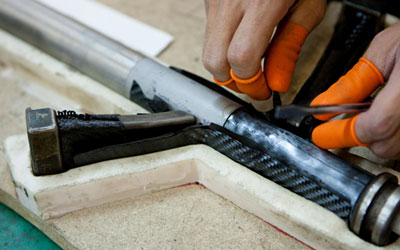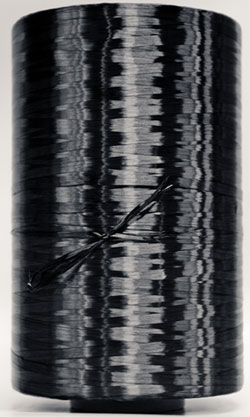
Today nearly all professional road cyclists have one thing in common:They almost all ride bikes with carbon fiber frames. This space-agematerial, which is one of the most popular composites in the sportinggoods industry, has many features that it make it a popular choice.
It is lightweight and easier to manipulate into shapes than other materials,including various metals, and it lasts and lasts.

That is actually a troubling issue, though. Carbon fiber, which atits most basic form is carbon graphite, will last virtually forever.The material is typically not biodegradable or photo-degradable. While a bicycle frame made of carbon fiber won’tdeteriorate over its useful lifetime, it also means that should theframe crack, break, or just no longer be desirable, itwon’t decompose in a landfill like other materials.
“It just sits and sits, and it is there for an eternity. It justdoesn’t go away,” said Andrew Juskaitis, spokesperson for Giant,the world’s largest producer of carbon fiber bicycle frames.
Because of this fact, it is something that companies such as Giant,Trek and Specialized have begun to address.
“It does fall upon our industry to collect the material — such as inused frames,” Juskaitis told TechNewsWorld.
Limited Supply Chain
At this week’s Interbike trade show in Las Vegas, most of the majormanufacturers will be introducing the latest in bicycles at all pricepoints. On the high end, there are bicycles with frames made ofaluminum, titanium and even steel, a material that is making acomeback.
However, given that the pro riders today sit on bikes with carbonfiber frames, many cycling enthusiasts are drawn to the spaceage material.
“People are walking into a bike shop and they want carbon fiber,”said Juskaitis.
The cost of carbon fiber tends to be high; Giant’sintro-level carbon fiber bike is priced around US$1,500. This is typical across the board, a fact that keeps thematerial somewhat limited to those serious enthusiasts.
The reasons are simple. For one, only a half dozen companies in theworld actually supply the bulk of carbon fiber. While sportinggoods are a large customer, the entire sporting goods industry isdwarfed by aerospace demands.
“The bicycle market is a drop in the bucket. That doesn’t mean it isn’timportant — but compared to what aircraft makers are using, we’re a dropin the bucket,” Juskaitis noted.
Recycling Efforts
The truth is that one Dreamliner aircraft uses more carbon fiber thanthe entire sporting goods industry in an entire year. Given thatplanes, just like bicycles, don’t last forever, that industry islooking closely at recycling as well. However, the bicycle industry –one that prides itself on green initiatives — isn’t letting theproblem roll by. Efforts are already being made to address it.

The problem is made worse by the fact that unlike plastics, aluminum andmany other materials, carbon fiber can’t be easily recycled. It won’t degrade, and it is extremely difficult to recycle.
The reason is that once it is in its product form, it needs to bechopped up to be recycled. The strength of the material is actually inthe fact that it consistes of long fibers. This gives it its rigidity and itsstrength — two things that are lost when it is cut.
“It doesn’t have its continuousfiber any longer,” noted Jeff Sloan, editor of Composites World.
Adding to the difficulty, only the fiber elements typicallycan be reclaimed. The bonding elements, such as the resins that hold thefiber in its eventual shape — like a bicycle frame — also need to be”removed” to reclaim the carbon fibers.
“When you talk reclaiming carbon fiber, you are just talking about theactual fibers,” Sloan told TechNewsWorld. “The rest of the materialsare burned off or otherwise wasted. This includes the resins, whichare not actually recycled.”
Diminished Value
One reason any product — whether it is plastic or aluminum — isrecycled is that it is typically cheaper to obtain reclaimed materialover virgin material. Unless that price is cheaper, most companies willcontinue to prefer virgin materials.

Here is another dilemma with carbon fiber: The costs, while high, are still too low to compel efforts to recycle it — andthe recycled materials have little value at the present time.
“You lose some value in the recycling process,” noted Sloan. “Therecycling curve of composites in general, and carbon fiber specifically,just isn’t that deep. The Dreamliner will help, as they’re going tohave to deal with what to do with the materials at the end of the plane’slifecycle.”
One added problem is that the cut fibers from a bicycle frame can’t beused to make another bicycle frame. The fibers from a planealso are cut into small pieces that can’t be used tomake a bicycle. That means lots of small squares of cut fibers with no particular purpose.
“We’ve been looking hard at this issue, and we’ve not found anything thatfits the bill perfectly at this point,” said Jim Colegrove, seniorcomposite manufacturing engineer with Trek Bicycle. “The key is finding that closed loop. We haven’t found that great use for thematerial yet. We’re still looking.”
Bulk Properties
One solution could be for use in bulk properties. Thus the cut piecescould be used in other products, those where the strength that ittypically provides isn’t required.
“You still have much of the stiffness, but you don’t have thecontinuous fiber,” added Colegrove. “You don’t have the strength.”
So what could this be? In the bicycle industry, it could be waterbottle cages. Other industries are using reclaimed carbon fiberfor laptop casings and mobile phone cases. Of course, a single bikecould provide material for many water bottle cages and thataforementioned airplane could make a lot of smartphone cases!
For now this is a problem without a solution, but one that the bicycleindustry is opting not to ignore, said Juskaitis. “We feel as a manufacturing brand that we’ll have a role in therecycling or responsible elimination of the material in the future.”






















































True, bike manufacturing companies have a role to play in the recycling cause. They use certain materials that may not decay with time, so they need to take action. This should serve as an eye opener for bike manufacturing companies like Trek and Morpheus. Hopefully, they’d give more emphasis on supporting recycling campaigns.